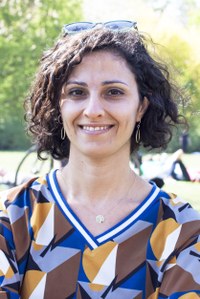Dr. Belkis Ezgi Arikan
 |
Postdoctoral researcher Room: 346, Building F2 |
My research uses behavioral (psychophysics) as well as fMRI methods to investigate how our actions influence our perception of the world, how we form predictions about our actions and their sensory consequences and how multiple sensory inputs influence these processes.
Scientific Training
|
Since 01/2019 |
Post-doc in the project "Prediction of somatosensory signals during hand movements" (SFB/TRR 135 "Cardinal mechanisms of perception") Justus-Liebig University Giessen, Germany |
|
11/2017 |
Ph.D., Cognitive Neuroscience, Philipps University Marburg, Germany Dissertation: Behavioral and Neural Indices of Perceiving Multisensory Action Outcomes. (Magna cum Laude). |
|
03/2012 |
M.Sc., Experimental Psychology, Hacettepe University, Turkey |
|
06/2007 |
B.Sc., Psychology, Middle East Technical University (METU), Turkey |
Team member in the project mentioned below
- DFG- (Grant) SFB/TRR 135: Predictive visual and somatosensory signals during hand and eye movements
Publications
-
Kavroulakis, E., van Kemenade, B. M., Arikan, B. E., Kircher, T., & Straube, B. (2022). The effect of self- vs. externally generated actions on timing, duration and amplitude of BOLD response for visual feedback processing. Human Brain Mapping, doi:10.1002/hbm.26053
-
Arikan, B.E., van Kemenade, B.M., Fiehler, K., Kircher, T., Drewing, K., Straube, B. (2021). Different contributions of efferent and reafferent feedback to sensorimotor temporal recalibration. Scientific Reports 11, 22631.
- Arikan*, B.E., Voudouris*, D., Gertz, H., Fiehler, K. (2021). Reach-relevant somatosensory signals modulate activity in the tactile suppression network. NeuroImage, Vol. 236, doi:10.1016/j.neuroimage.2021.118000. *shared first authorship
- Arikan, B.E., van Kemenade, B.M., Podranski, K., Steinsträter, O., Straube, B. Kircher, T. (2019). Perceiving your hand moving: BOLD suppression in sensory cortices and the role of the cerebellum in the detection of feedback delays. Journal of Vision Vol.19, 4, doi:10.1167/19.14.4
-
van Kemenade, B.M., Arikan, B.E., Podranski, K., Steinsträter, O., Kircher, T., Straube, B. (2018). Distinct roles for the cerebellum, angular gyrus and middle temporal gyrus in action-feedback monitoring. Cereb. Cortex, bhy048, doi:10.1093/cercor/bhy048.
-
Arikan, B.E., van Kemenade, B.M., Harris, L.R., Straube, B., Kircher, T. (2017). Voluntary and involuntary movements widen the window of subjective simultaneity. Iperception 8(4), doi:10.1177/2041669517719297.
-
van Kemenade, B.M., Arikan, B.E., Kircher, T., Straube, B.(2017). The angular gyrus is a supramodal comparator area in action–outcome monitoring. Brain Struct Func., 1-13, 28439662, doi:10.1007/s00429-017-1428-9.
-
Straube, B., van Kemenade, B.M., Arikan, B.E., Fiehler, K., Leube, D.T., Harris, L.R., Kircher, T. (2017). Predicting the Multisensory Consequences of One’s Own Action: BOLD Suppression in Auditory and Visual Cortices. PLoS One 12, e0169131. doi:10.1371/journal.pone.0169131.
-
van Kemenade, B.M., Arikan, B.E., Kircher, T., Straube, B. (2016). Predicting the sensory consequences of one’s own action: First evidence for multisensory facilitation, Atten Percept Psychophys.,1-12. doi:10.3758/s13414-016-1189-1.
